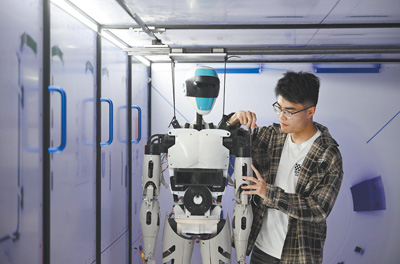China sees accelerated application of humanoid robots
Various kinds of humanoid robots, including those that can dance and provide guided tours, captivated crowds of visitors at the China Brand Day 2024 events, which kicked off in Shanghai on May 12.
China's humanoid robot industry witnessed explosive growth in 2023, with the industry scale increasing by 85.7 percent year on year to 3.91 billion yuan ($539.66 million), according to a research report on the country's humanoid robot sector in 2024 issued by the China Center for Information Industry Development.

A researcher debugs a humanoid robot at a lab of Huzhou Institute of Zhejiang University in Nantaihu New Area, Huzhou city, east China's Zhejiang Province. (Photo/Huang Yangyang)
The country's humanoid robot industry is expected to continue to grow rapidly in 2024 and 2025, and the scale of the sector will exceed 20 billion yuan in 2026.
China's Ministry of Industry and Information Technology (MIIT) issued a guideline in November 2023 to promote the nation's innovative development of humanoid robots.
The country aims to establish an initial humanoid robot innovation system by 2025, and to have globally leading comprehensive strength in the humanoid robot industry to turn the sector into an essential new engine of economic growth by 2027, according to the guideline.
The humanoid robot, which integrates advanced technologies such as artificial intelligence (AI), high-end manufacturing and new materials, is expected to become the next disruptive product after computers, smartphones, and new energy vehicles, and to profoundly change people's approaches to life and work.
"The humanoid robot sector represents advanced manufacturing, and its development will drive the coordinated development of high-end industries such as mechanics, electronics, sensing, software, communications, and AI," said Zhou Jian, chairman and CEO of UBTech Robotics Corp Ltd (UBTech Robotics) based in Shenzhen, south China's Guangdong Province.
Compared to traditional industrial robots, humanoid robots are more flexible and intelligent, capable of taking on more strenuous and tedious jobs and significantly alleviating labor shortages in the manufacturing sector, Zhou noted.
Early this year, a humanoid robot performed quality checks on car door locks and rear light covers, tested seat belts, and even affixed car emblems in the factory of Chinese electric vehicle maker NIO located in Hefei, capital of east China's Anhui Province.
The robot, Walker S, is produced by UBTech Robotics. Some automakers have already put forward detailed procurement plans, Zhou said, adding that the automobile manufacturing industry is expected to witness large-scale application of humanoid robots.
Humanoid robots are also seeing rapid application in the commercial services sector. For example, the first batch of Walker X robots developed by UBTech Robotics became the first generation of humanoid service robots for NEOM, Saudi Arabia's futuristic city.
In terms of major commercial application scenarios, the guideline proposed focusing on creating highly reliable, safe and stable humanoid robot solutions for special fields, manufacturing scenarios, people's livelihood and key industries such as agriculture and logistics.
Huang Xiaoqing, founder and CEO of Chinese company Dataa Robotics, believes that households hold the greatest potential for humanoid robot applications in the future. Huang added since the company started research and development of humanoid robots in 2015, its goal has been to bring service robots to ordinary families’ homes as soon as possible.
After years of dedicated efforts, UBTech Robotics has established a comprehensive portfolio of core technologies, including servo drive, motion control, computer vision, and robot hardware and software design. As of the end of 2023, it possessed more than 2,100 patents on humanoid robots, over 400 of which are overseas patents, and invention patents accounting for more than 50 percent of its total.
According to a report on humanoid robot technology patents released by the Research Institute of the People's Daily Online in late 2023, China has made steady progress from being a follower to a leader in humanoid robot technology patents in less than a decade, ranking first in both patent filings and valid patents for humanoid robot technology.
Last year, the integrated development of the humanoid robot industry with cutting-edge technologies such as AI, new materials, metaverse, and brain-computer interface greatly accelerated the innovation of crucial components of humanoid robots such as "brains, cerebellum, and limbs," said Xiong Youjun, chief technical officer of UBTech Robotics.
Xiong suggested that relevant departments introduce policies to support and encourage enterprises in using humanoid robots, cultivate the humanoid robot market, and give full play to the advantages of China's huge market to help the country seize the initiative for the future development of the humanoid robot industry.
Photos
Related Stories
- China New Growth: Ascending local brands make their mark on rising robots
- From robots to peacocks, the evolution of China's factories
- Students from Harbin Institute of Technology showcase tech marvels in Heilongjiang
- Industrial robot makers gear up for global expansion
- China's humanoid robot market to hit 10 billion yuan, eyes 119 billion yuan by 2030: report
- Tea picking robot operates in harvest season
- China's Northwestern Polytechnical University develops AI robotic guide dog
- Humanoid robot competition in Beijing draws visitors
Copyright © 2024 People's Daily Online. All Rights Reserved.









